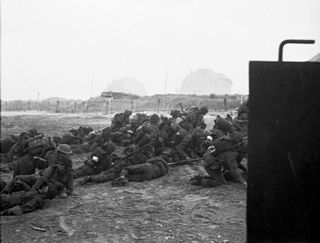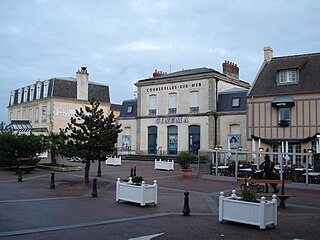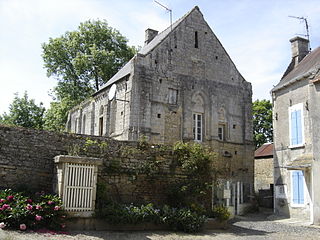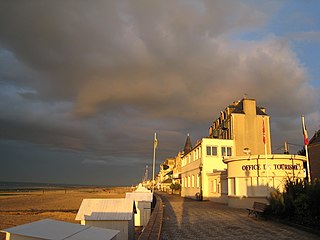
Juno or Juno Beach was one of five beaches of the Allied invasion of German-occupied France in the Normandy landings on 6 June 1944 during the Second World War. The beach spanned from Courseulles, a village just east of the British beach Gold, to Saint-Aubin-sur-Mer, and just west of the British beach Sword. Taking Juno was the responsibility of the Canadian Army, with sea transport, mine sweeping, and a naval bombardment force provided by the Royal Canadian Navy and the British Royal Navy as well as elements from the Free French, Norwegian, and other Allied navies. The objectives of the 3rd Canadian Infantry Division on D-Day were to cut the Caen-Bayeux road, seize the Carpiquet airport west of Caen, and form a link between the two British beaches on either flank.

Sword, commonly known as Sword Beach, was the code name given to one of the five main landing areas along the Normandy coast during the initial assault phase, Operation Neptune, of Operation Overlord, the Allied invasion of German-occupied France that commenced on 6 June 1944. Stretching 8 kilometres (5.0 mi) from Ouistreham to Saint-Aubin-sur-Mer, the beach proved to be the easternmost landing site of the invasion after the abortion of an attack on a sixth beach, code-named Band. Taking Sword was to be the responsibility of the British Army with sea transport, mine sweeping, and a naval bombardment force provided by the British Royal Navy as well as elements from the Polish, Norwegian and other Allied navies.

Operation Gambit was a part of Operation Neptune, the landing phase of the invasion of northern France during the Second World War. Gambit involved two X class submarines marking the ends of the Anglo-Canadian invasion beaches. Using navigation lights and flags, the submarines indicated the western and eastern limits of Sword and Juno Beaches. X20 and X23 arrived in position on 4 June and due to the delay caused by bad weather, remained in position until 4:30 a.m. on 6 June (D-Day) when they surfaced, erected the navigational aids, an 18 ft (5.5 m) telescopic mast with a light shining to seaward, a radio beacon and echo sounder, tapping out a message for the minelayers approaching Sword and Juno.

Mulberry harbours were temporary portable harbours developed by the United Kingdom during the Second World War to facilitate the rapid offloading of cargo onto beaches during the Allied invasion of Normandy in June 1944. After the Allies successfully held beachheads following D-Day, two prefabricated harbours were taken in sections across the English Channel from the UK with the invading army and assembled off Omaha Beach and Gold Beach.

Operation Jubilee or the Dieppe Raid was an Allied amphibious attack on the German-occupied port of Dieppe in northern France, during the Second World War. Over 6,050 infantry, predominantly Canadian, supported by a regiment of tanks, were put ashore from a naval force operating under protection of Royal Air Force (RAF) fighters.

Bény-sur-Mer is a commune in the Calvados department (14) in the Normandy region, la Basse-Normandie, in northwestern France, 4.7 km from Bernières-sur-Mer and 5.2 km from Saint-Aubin-sur-Mer. Bény-sur-Mer was liberated on D-Day by Le Régiment de la Chaudière, a French Canadian unit. There was a gun battery located near the town at the time. The locals were surprised to have been liberated by fellow francophones, expecting only English-speaking troops.

Bernières-sur-Mer, in the arrondissement of Caen, is a commune in the Calvados department of Normandy, in northwestern France. Administratively, in the Township of Douvres-la-Délivrande, along its coast the town is 2.1 km to Saint Aubin-sur-Mer, 2.5 km to Courseulles-sur-Mer, and driving south is 4.7 to Beny-sur-Mer.

Courseulles-sur-Mer, commonly known as Courseulles, is a commune in the Calvados department, Normandy, northwestern France, located about 1.1 km from Graye-sur-Mer, and 3.3 km from Reviers. Until 1957, the town's name was simply Courseulles.

Graye-sur-Mer is a commune in the Calvados department (14) in the Normandy region, in northwestern France, 1.1 km from Courseulles-sur-Mer, and 3.4 km from Sainte-Croix-sur-Mer.

Reviers is a commune in the Calvados department (14) in the Normandy region, la Basse-Normandie, in northwestern France, 6 km from Creully, and 3.3 km from Courselles-sur-Mer. It is affected by three rivers: la Seulles, to its west, it flowing north to Courselles-sur-Mer, la Mue, which joins la Seulles, north of the town, and le Douet, which joins la Mue, in the centre of the town. There is bridge west of Reviers, over la Seulles, on the principal road (D176) connecting to Colombiers-sur-Seulles (3.23 km), and a bridge in Reviers, over la Mue, on the principal road (D35), connecting east to Tailleville.

Saint Aubin-sur-Mer, in the District of Caen, is a commune in the Calvados department (14), of la Basse-Normandie (25), in northwestern France. Administratively, in the Township of Douvres-la-Délivrande, along its coast the town is 2.1 km to Bernieres-sur-Mer, and driving south is 5.1 to Beny-sur-Mer.

The United States Naval Special Warfare Command (USNSWC), also known as, is the naval component of United States Special Operations Command, the unified command responsible for overseeing and conducting the nation's special operations and missions.

The X class was a World War II midget submarine class built for the Royal Navy during 1943–44. It was substantially larger than the original Chariot manned torpedo.

Combined Operations Headquarters was a department of the British War Office set up during Second World War to harass the Germans on the European continent by means of raids carried out by use of combined naval and army forces.

The Canadian Army Film and Photo Unit (CFPU) was a Canadian Army unit founded in 1941 in order to document military operations during World War II. It was the last unit of its kind to be founded by the Allied armies. Among the campaigns which it recorded were the invasion of Sicily, the D-Day Landings, the liberation of Paris and the Elbe River link-up of the Allied armies, known as 'Elbe Day'.
The 4th Special Service Brigade was a brigade-sized formation of the British Commandos formed during the Second World War in March 1944 from battalion-sized units of the Royal Marines. Due to the success of the British Army Commandos' operations in Norway, the Channel Islands, St. Nazaire, and the Middle East, the Admiralty dissolved the Royal Marines Division in late 1942 and reorganized its amphibious assault infantry into eight additional Commando units.
Major General Logan Scott-Bowden, was a British army officer. A Royal Engineers officer during World War II, he was the first commander of the Ulster Defence Regiment. Retiring as a Major General in 1974, he served as the Colonel-Commandant of the Royal Engineers from 1975 to 1980.

Amphibious reconnaissance is ground and naval reconnaissance in the littoral area bordering coastal or ocean areas. Initially, it is used for preliminary reconnaissance in collecting pertinent information about the beachhead in its permeability and usability for main landing assaults. Specialized recon patrols skilled in boatswain and combatant diving using either amphibious vehicles or rubber crafts to obtain and collect information on the enemy, the topology ashore and inland, and hydrographic surveys for underwater obstacles and mines, and for the purpose of affecting a deception.

This is the Juno Beach order of battle on D-Day.

The Australian contribution to the Battle of Normandy involved more than 3,000 military personnel serving under British command. The majority of these personnel were members of the Royal Australian Air Force (RAAF), though smaller numbers of Australians serving with the Royal Navy and British Army also participated in the fighting prior to and after the Allied landings on 6 June 1944. While all the RAAF units based in the United Kingdom (UK) took part in the battle, Australians made up only a small portion of the Allied force.


















